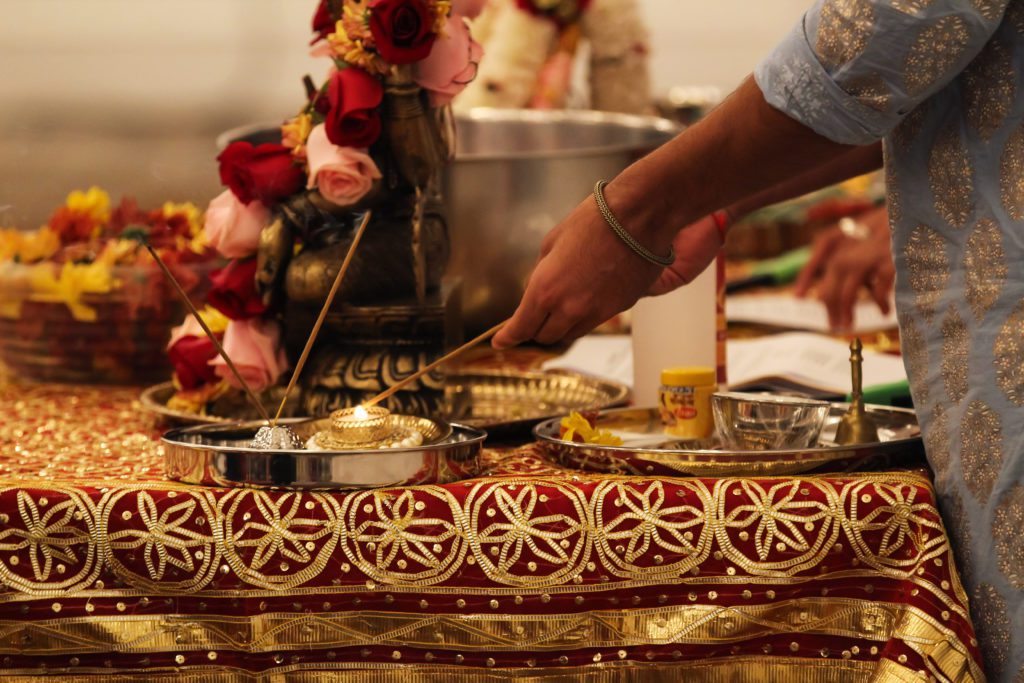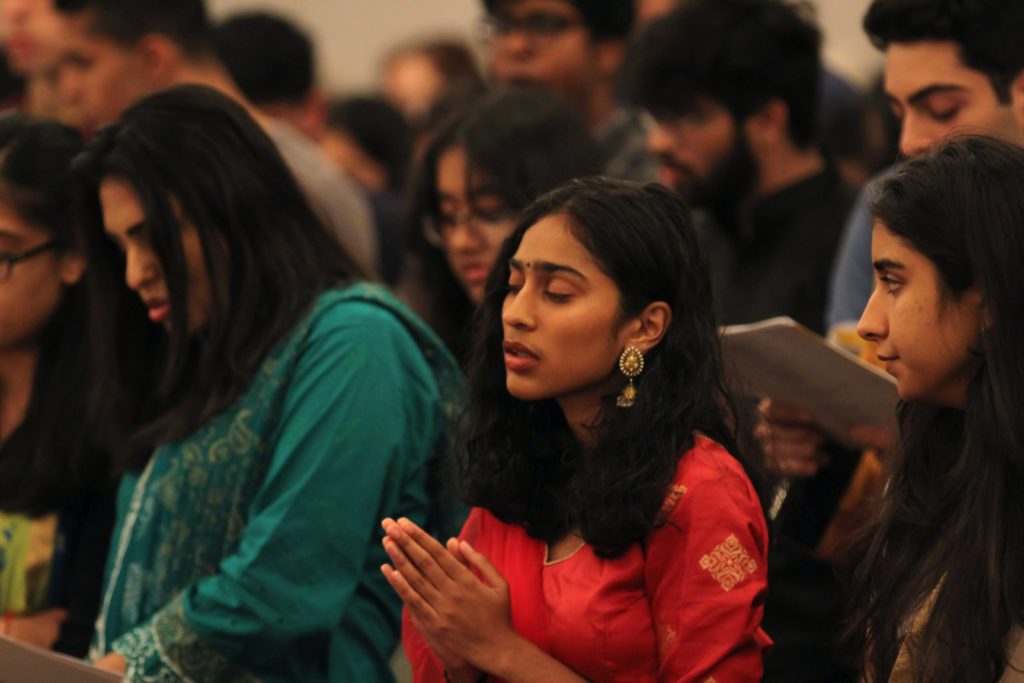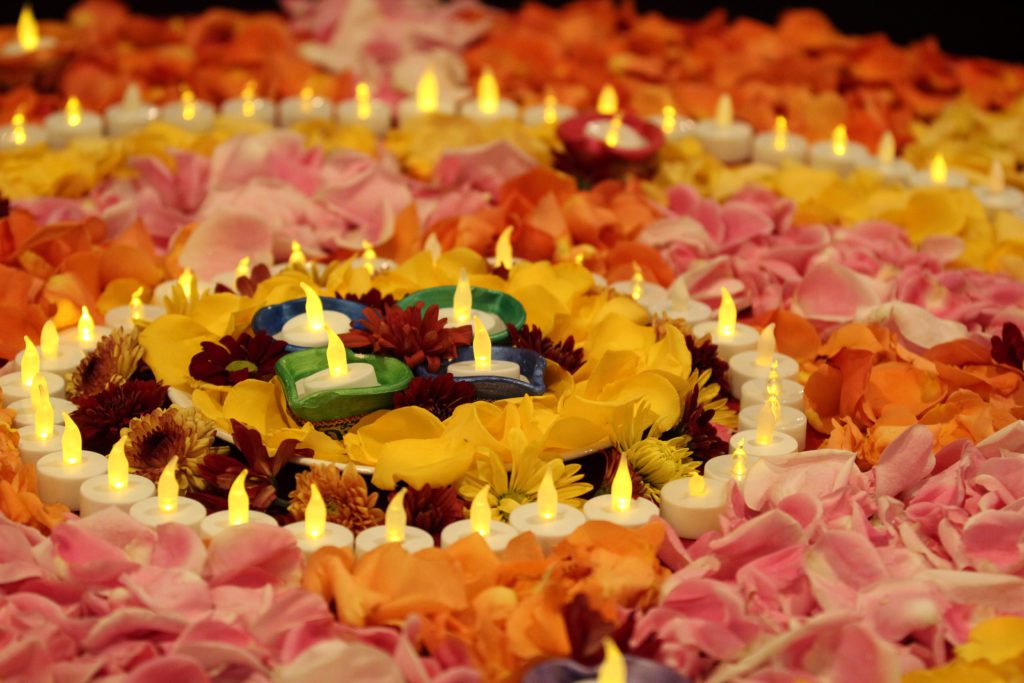“Carefree celebration”: Yalies celebrate festival of lights
Last week, the Yale Hindu Students Organization and Chaplain’s Office co-hosted a Diwali puja at the Omni Hotel. Students of other religious and cultural backgrounds also celebrated holidays that fall on the day of the new moon.

Giri Viswanathan, Photography Editor
On the darkest day of the Hindu lunar month Kartik, which typically lasts from mid-October to mid-November, over one billion people across the world celebrated Diwali — which fell on Oct. 24 this year.
Diwali, also known as Deepavali, marks the Hindu Festival of Lights. Observers traditionally illuminate their homes — often with diyas, which can be clay lamps or tea lights — to dispel darkness and instead invite Lakshmi, the goddess of prosperity and fortune, into their homes. The holy day also holds significance for Sikhs and Jains, and is celebrated in India, Nepal, Singapore, Sri Lanka, Guyana, Malaysia and other countries with South Asian diasporas.
On Oct. 28, the Yale Hindu Students Organization and the Chaplain’s Office co-hosted the puja — or prayer — to Maha Lakshmi at the Omni Hotel, with a catered vegetarian Indian dinner following the service.
“Celebrating Diwali for me was way more than observing a religious festival,” wrote Maanasi Nair ’25. “Diwali to me means carefree celebration, filled with the warmth of friends, family, good food and a lot of mutual love for everyone. Connecting with the larger community and seeing everyone there genuinely enjoy themselves really did touch me, and left me feeling so much more rejuvenated.”

For Nair, who is from Bangalore, India, celebrating Diwali at Yale was “comforting,” especially while being far from home. Nair is also vice president of India at Yale, an undergraduate association that describes themselves as working to host social and political events that bring the Indian community closer and proliferate interest and awareness about Indian issues on campus.
In an email to the News, Director of Hindu Life Asha Shipman explained that Diwali is a five-day celebration, with the third day — the Lakshmi Puja — considered the main day.
Even within Hinduism, there are various legends behind the celebration of Diwali. The most popular Hindu legend comes from the Rāmāyana, a Sanskrit epic that tells the story of the exiled Prince Rama.
According to the Rāmāyana, Diwali marks the day that Rama, his brother Lakshmana and his wife Sita return to their kingdom of Ayodhya after a 14-year exile. Here, the lighting of the lamps on Diwali represents the people of Ayodhya lighting the way home for Rama, Lakshmana and Sita.
“In this sacred story the Divine is born in mortal form as Lord Rāma, a Hindu prince,” Shipman wrote. “He is born to restore the balance of good and evil in the world. This third day of Diwali is celebrated as the day that Lord Rama is said to have returned to Ayodhyā after quelling the forces of evil.”
In Sikhism, the day is celebrated as Bandi Chhor Divas, which translates to Day of Liberation. The Sikh holiday commemorates the historical freeing of the sixth Guru, or teacher, of the Sikhs. Guru Hargobind Singh Ji released 52 prisoners from Gwalior Fort, who had been imprisoned by Mughal Emperor Jahangir.
Sikhs often celebrate Bandi Chhor Divas by lighting up their homes and gurudwaras — Sikh places of worship, whose name translates from Punjabi into “doorway to the Guru” — and through celebratory processions. Some also put on fireworks displays to honor the day.
In Jainism, Diwali marks the nirvana, the spiritual awakening or liberation, of Lord Mahavira’s soul. Lord Mahavira is the twenty-fourth Tirthankara, or, roughly, supreme preacher, and also the last Tirthankara of the current cycle of the Jain cosmic wheel of time. Some Jain scriptures refer to the day as Diaplikaya, which refers to light leaving the body.
Lord Mahavira is said to have attained his nirvana at the dawn of the new moon, or the darkest day of the lunar month. According to the Kalpa Sūtra, a Jain text containing the biographies of the Jain Tirthankaras, many gods were present during the event and illuminated the darkness. However, the following night was pitch black, as neither the gods nor the moon were present. As such, Jains light candles and lamps to symbolically preserve the light of Mahavira’s knowledge.
Shipman noted that many consider Diwali to be a “pan-Indian festival” regardless of religious affiliation. Often, Yale Hindu community members invite non-Hindu friends to join the celebration.
“Holy days and festivals can be a time of great homesickness for our Hindu community members who are missing the rituals, customs, flavors, sounds and sights of these important annual events,” Shipman wrote. “Last year during our Diwali celebration a graduate student from India shared with me that attending Diwali puja made him feel like he was at home – for the first time since he joined Yale.”

Sikhs at Yale celebrates Bandi Chhor Divas
Some Sikh students at Yale are part of Sikhs at Yale, an undergraduate organization that aims to raise the cultural and spiritual awareness of the Sikh faith among Sikh and non-Sikhs alike on Yale’s campus.
Normally, Sikhs would go to the gurudwara on Bandi Chhor Divas. There, they light diyas and keep them lit until the flame dies out.
Last year, SAY students took a trip to the nearest gurudwara, which is in Hamden. This year, however, the holiday fell on the Monday after fall break, so they were not able to attend. Instead, they plan to go on a subsequent weekend.
“Even if it’s post-facto, I think it will be a good thing to celebrate it,” said Jasmin Gill ’23, the president of SAY.
Explaining the story of Bandi Chhor Divas, Gill noted that the holiday’s name literally translates to “prisoner release day.” She explained that the sixth Guru, Hargobind, was imprisoned in the Gwalior Fort through conflict with the Mughal empire — and though his personal release was negotiated, there were 52 other kings and princes who were imprisoned alongside him by the Mughals.
“He said, ‘I won’t leave by myself, I want to release these ones, too,’” Gill explained. “The people who were imprisoning him [told him] however many prisoners could hold onto his clothes could leave with him, so Guru had a special cloak embroidered with 52 threads hanging off the back of it such that each raja, or prince, was able to hold on and then be released.”
According to Gill, when Sikhs heard that Guru Hargobind Ji was being released, the Punjabi city of Amritsar — one of the holiest places in the Sikh religion — lit up with diyas, fireworks and all kinds of celebrations of light. The Golden Temple, a central and holy religious place for Sikhs, is located in Amritsar.
Gill is from Lodi, California, near Stockton, where the first gurudwara in America was built. She grew up going to the Stockton gurudwara and was surrounded by a strong Sikh community.
“Overall, there are not too many Sikhs at Yale,” Gill said. “There’s big communities all over America, kind of centered in California, New Jersey, Texas, but there’s not too many at Yale. I think in my first year, there were maybe 15 people total in the GroupMe.”
Looking forward, Gill hopes to get more sophomore and first-years involved with SAY, especially because most of the executive board are seniors.
Speaking of the holiday, Gill pointed out similarities in the themes of the Hindu and the Sikh holiday.
“The Hindu celebration is a celebration of light over darkness in Hindu gods and in battle,” Gill said. “[Bandi Chhor Divas] is completely different historically, but it’s the same message of light defeating the darkness. And again, the whole concept of Bandi Chhor is applied metaphorically too, of how God or the gurus are the freer of the imprisoned. They also free the people who practice the religion from the prison of vice and sin.”

Nepali Students Society celebrate Tihar
The Nepali Students Society, a newly-formed association, also organized celebrations of the holiday.
Nikita Paudel ’25, president of the society, described the Nepali sequence of events. Paudel noted that for Nepalis, the holiday is called Tihar — which essentially translates to “celebration.” Tihar, as Paudel explained, is a five-day celebration. Among these are Kaag Tihar, Kukur Tihar, Lakshmi Puja and Gai Tihar, Govardhan Puja and Bhai Tika.
In Kaag Tihar, Paudel explained that observers celebrate crows; similarly, Gai Tihar is for cows. In Kukur Tihar, Nepali observers honor “the love and loyalness” from dogs, as Paudel put it. This year, at the Nepali Students Society’s Kukur Tihar observation, Yale’s Handsome Dan made an appearance.
Lakshmi Puja is a day dedicated to celebrating women and the “prosperity” that they bring. During this day, Paudel said they decorate homes with lights and color, as well as rangolis, which are colorful, often circular designs placed in front of doorsteps. The goal is to welcome the goddess Lakshmi into the home.
The final day is Bhai Tika, which is when sisters place a seven-colored line on their brothers’ forehead, and brothers offer gifts in return. For the Nepali students’ celebration of Bhai Tika on Oct. 27, undergraduate and graduate students came together at Luce Hall, offering food and gifts for all present.
Paudel launched the Nepali Students Society after observing a lack of space for Nepali students on campus.
“There’s a lot of South Asian spaces, but Nepal is very unique because we’re also considered a Himalayan country,” Paudel explained. “We do have very close ties as well to Tibet, Bhutan, and even China in some cases, so we’re like an amalgamation of all the different Asian countries around us. So we really wanted to create a space for all Nepali people to come and be comfortable.”
Paudel noted an acute lack of awareness of Nepal and of Nepali issues on campus, specifically describing occurrences of being asked if Nepal is in India or if it is in China. As such, the group’s goals are to promote Nepali awareness, from cultural and religious affairs to activist work, and to encourage other Nepali people to apply to Yale.
“We really wanted to make sure that people on campus know where our country is and how proud we are to be here,” she said.
Per Paudel, there are about 15 total Nepali undergraduates at Yale. Including graduate and postdoctorate students, as well as residents, in that figure, Paudel says there are around 32 Nepali Yale affiliates — “bigger than I could have ever expected.”
For the Nepali Students Society, Tihar may be one of their biggest events of the year, but it is not their only one.
Going forward, Paudel hopes to also work on events and campaigns highlighting migrant and workers’ rights abuses of Nepali and other South Asian minority workers in Qatar, particularly with the World Cup — which Qatar is hosting — on the horizon.
“It’s like bringing home to us,” Paudel said, speaking of the society and their events.
Paudel began to form the Nepali Students Society last spring, during her first year at Yale.
Correction, Nov. 2: Two paragraphs in this story were corrected on Oct. 31 to appropriately note that Gai Tihar celebrates cows and to fix a spelling error in Maha Lakshmi’s name. A previous version of this story called Gai Tihar a celebration of camels.








